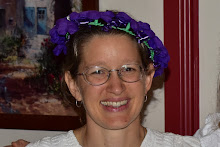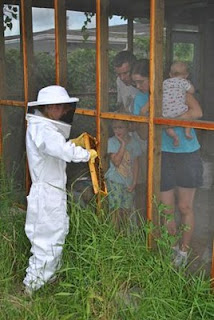
There's nothing like finally doing something you've been dreaming of for half your life.
When my family lived in Jordan during my teens, I joined the Royal Jordanian Gliding Club. Gliding was an important part of my life for most of my time there, and I tried to fly every weekend. However, there were a number of aspects to the experience that failed to be awesome, despite the thrill of the actual gliding. There was no set curriculum or record keeping that I was aware of. I was given an exam in order to get my student pilot license, but during the exam, the other student in the room cheated flagrantly. If it was cheating at all. If the test question was, "What is the empty weight of the glider?", the student asked the adjudicator, "Excuse me, sir, but what is the empty weight of the glider?" He helpfully responded with the correct answer. Needless to say, I had little respect for the test. I was torn, ethically, over whether or not I should write down the answers I overheard if I couldn't remember them on my own. I was never told what my own results were, but I was given my license a few weeks later.
However, I never seemed to get any closer to the first major goal of a student pilot: the solo flight, when you get to be the sole occupant of the aircraft for an entire flight. On vacation in South Africa when I was 16, my parents got me a flight in a motor glider as a special treat. After handing me the controls and watching me fly, the pilot commented, "You must be just about to solo." Back in Jordan, a year later, with at least 50 more flights' worth of experience, I still had not. On one occasion, one of the instructors asked, seemingly in passing, "Do you think you might be able to come more than once a week?" I explained that the other days the club was in operation were school days, and no more was said on the subject. I thought nothing of it until the day my dad finally confronted them.
"We're only letting her fly because she's your daughter." That was the main result of my dad's request for some kind of time estimate on when I might expect to solo a glider. My dad, you see, was a VIP, a high official in the South African Embassy in Jordan. Having a diplomat associated with their club made them look good. My dad and I both got the impression that, had I been someone else's daughter, the mental deficiency that my gender implied would have prevented them from letting me get even this far. Needless to say, we were both angry. Trying to backpedal, one of the instructors said, "Besides, we already told her she needed to fly a lot more often."
Perhaps if I'd been more culturally savvy, I would have realized that the mild suggestion was actually a requirement. Then again, perhaps if I'd been more culturally savvy, I would have realized I had no chance in the first place. In any case, I stopped gliding. It took me a while before seeing an aircraft in flight didn't bring me close to tears. I thought, "When I move back to a 1st world country, I'll take this up again."
Time and money. Those are the two main obstacles to any number of pursuits, and flying is certainly one of them. However, Ari's parents have given us a number of financial gifts over the years, and now that he's working from home, our schedules are a lot more flexible. Last November, the two of us were hiking together when Ari suggested, "What would you think of taking flying lessons?" I believe I stopped in my tracks, dumbfounded. I had stopped thinking about flying at all, but with the realization that it was now possible, I started to dream again. It took him a good bit of effort to convince me to spend our money on something that, at least for the time being, would be purely for my enjoyment, but I finally acquiesced. On my 30th birthday, Ari got me a discovery flight at the West Houston Airport.
Oh, paperwork is another obstacle. Being an evil foreigner, the FAA had to make sure I wasn't just learning to fly in order to cause chaos and mayhem (of course, it makes sense for them to be concerned). They make sure you're not out to cause trouble by checking your fingerprints against those of known Bad People. This was harder for me than it sounds because almost every one of the 10 or so steps I had to follow produced its own glitch. However, I finally started lessons in June, 2 months after my discovery flight.
What a difference from my experience in Jordan! For one thing, there's the Ninety-Nines, an international organization of women pilots, the local chapter of which meets monthly at West Houston Airport. It's such an encouragement to enter a roomful of women who all have pilot certificates. More importantly, the entire outfit is so much more professional. It has been clear from the outset that each lesson has a purpose, and brings me closer to the goal, first of soloing and ultimately of getting my private pilot certificate.
The past month or two of lessons, I've mainly been working on landings. There are so many things to think about - making radio calls, making turns at exactly the right time, keeping the airspeed high enough but not too high, extending the flaps at the right time, keeping the nose pointed down the center line of the runway no matter what the wind is doing, starting the roundout and flare at the right moment and flaring enough to get the nose up but not so much that you stall too high and drop onto the runway, and deciding to go around if you know you forgot something and it's going to be a bad landing.
A month ago or so, my instructor gave me the required pre-solo exam, which I passed with an almost perfect score. (No, I didn't ask him for the answers - it was a take-home). He told me he was now just looking for me to make 3 good landings, preferably in a row, preferably the first 3 landings in the lesson, and he'd let me solo. For the next 6 lessons or so (I've been flying twice a week), I got increasinly frustrated at myself. I'd make a good landing, then a bad one, then a good one, then 2 bad ones, always bad in different ways. I'd think about what I'd done wrong last time, focus on fixing that, and let something else slip.
Last Wednesday, I almost had it. Every time, it seemed like the landing was just beautiful until the last second, when I would relax the pressure I was putting on the right rudder, and the nose would swing to the left, and I'd weave all over the runway. Then on Saturday, the wind was blowing from the opposite direction to what I'm used to, so we took off from the opposite end of the runway from usual. The change in scenery threw me off, and I was back to making different mistakes each landing (though I at least kept the right rudder in!). I counted up the flight hours and landings recorded in my logbook - over 30 hours, and over 100 landings. Surely I must be the slowest learner in the history of aviation! But I googled "taking a long time to solo," and came up with stories of other pilots who had taken a good bit longer than that, so I came to my lesson this morning feeling slightly happier about myself.

The wind was back to normal, the skies clear, the air chilly enough to justify wearing a sweatshirt. I did 2 landings with minor errors and was wondering if they counted as "good". As I was about to roundout for the 3rd landing, my instructor told me to go around. I thought, "That's odd. I thought it looked about perfect." But I increased throttle and lifted the flaps (forgetting to lift them incrementally, so the plane lost a lot of lift at once), went around the traffic pattern again, and brought it in for a reasonably good landing. I felt pretty good about them, but I wasn't sure what my instructor thought.
"Okay, I'm bored. Take me back to the ramp so I can take a nap. You take this thing up yourself." I broke into a huge grin. I grinned as I taxied back to the ramp, as he endorsed my logbook and student pilot certificate, as he told me to go around if I didn't think it was working out (that's why he had me practice it), as he jumped out of the airplane and asked me if I had any last words, and as he leaned in again to tell me to take it around the pattern 3 times.
I was expecting to feel more nervous than I really did. I sang as I taxied to the end of the runway, wiped the grin off my face long enough to radio my intentions, and took off. Apart from the plane climbing faster with only one occupant, it was just like what I've been doing multiple times a lesson twice a week for the past few months. There's enough to think about when flying that I didn't have attention to spare for anything other than a general sense of extreme happiness. Knowing that there was no-one to take over for me if I did anything wrong just helped me to focus harder. The second landing was the best I've ever done. By the 3rd landing, I was feeling a touch overconfident, came down hard, and bounced it. My instructor sat on a luggage cart on the side of the taxiway and watched me, waving to me each time around. When I had parked the airplane, he congratulated me and told me the second landing was beautiful.
There's a tradition that, after your first solo, the instructor cuts out the back of your t-shirt and signs it. Stacy, a fellow Ninety-Nine who works at the desk, told me the origin of this tradition. Back in ancient days of yore, when aircraft held only 2 people seated single file, radios were nonexistent, and the engine was too loud to yell over, the flight instructor would sit behind his student and communicate by tugging on his shirt to show him where to go. When the student was ready to solo, he no longer needed the instructor to tug on his shirt.

So, I now have a cut up t-shirt and a tremendous sense of accomplishment. It's a remarkable feeling, to lose a dream and receive it back better than before. Thank you, Lord!
(Photo credits: Aircraft in flight and on ground: Ant and Eva Greenham; Solo picture: Brian Padar (my instructor)).


















